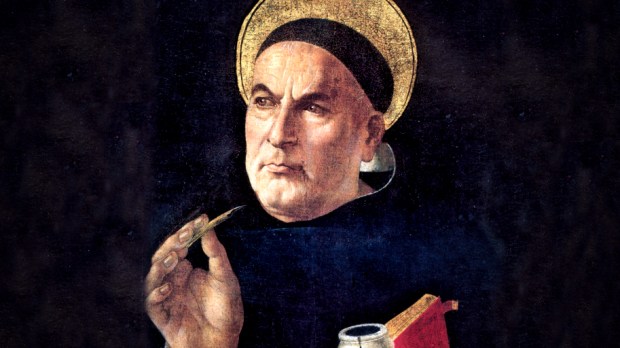January 28 is the feast of this great saint and doctor of the Church, the patron of students and Catholic schools. Thomas is one of the most brilliant philosophers and theologians the Catholic Church has ever had. Perhaps because of his reputation as an intellectual heavyweight, he might seem a bit intimidating to us. Can I really relate to a medieval saint who spent his life immersed in books and teaching? Yes!
Thomas was a very human saint, one who can be a great model for us in many ways. Physically he was a big man, and Thomas was a gentle giant, known for his humility and kindness to others. Here are some things about him that are fun to know:
1. He was born and grew up in a castle.
Thomas was from a well-to-do family in Roccasecca, Italy. He had three brothers and five sisters.
2. He had a lifelong fear of storms.
That’s probably because when he was a toddler, his infant sister was killed by lightning when they were both taking a nap in the same room. Later in life, Thomas always carried a relic of St. Agnes and prayed to her for protection during storms.
3. When he was a boy he was sent to study at the famous monastery of Monte Cassino.
He stayed there through his teens and probably became a Benedictine oblate. While there Thomas got to know the spiritual writings of Saint John Cassian, which he treasured throughout his life.
4. He ran away from home to follow his Dominican vocation.
His family wouldn’t have objected to him staying at Monte Cassino in view of becoming the abbot. But they just couldn’t understand why Thomas wanted to become a Dominican. For them it was a step down in the world, since the Dominicans were itinerant preachers and went around begging. They tried to persuade him to drop the idea, but that didn’t work.
5. He was stubborn.
When his family found out he had joined the Dominicans, a band of soldiers led by his brother Rinaldo captured Thomas and brought him back home. He spent about a year under a sort of house arrest while his family tried to persuade him to give up his dream. He did not.
6. He was called the “dumb ox.”
This is often misunderstood. It didn’t mean that the other students thought he was unintelligent. They called him that because he was very quiet and didn’t talk much.
7. He had terrible handwriting.
It was so bad it’s called in Latin the littera inintelligibilis. So if anyone has ever criticized your handwriting, take heart, you’re just like Aquinas!
8. He could dictate to two or three secretaries at once.
His handwriting didn’t matter because he usually dictated to secretaries. Although it may seem incredible, it’s well documented that Thomas could dictate to a few of them at one time. He could think a lot faster than they could write.
9. He never criticized people; he only critiqued ideas.
The closest he ever came to criticizing someone in his writings was when he called an opinion of a certain David of Dinant stultissimus, which loosely translated means, “wow, what a stupid idea!” But it was the idea he was criticizing, not David.
10. He was extremely humble and submitted all his work to the judgment of the Church.
At the point of death, he said, “I have taught and written much … according to my faith in Jesus Christ and the holy Roman Church, to whose judgment I submit all my teaching.”
Amen! Saint Thomas Aquinas, pray for us!
~
Sr. Marianne Lorraine Trouvé has a new book on Thomas Aquinas,the newest volume in the Saints by Our Side series. She is well known for her blog Thomas for Today, from which this article is reprinted with kind permission.

